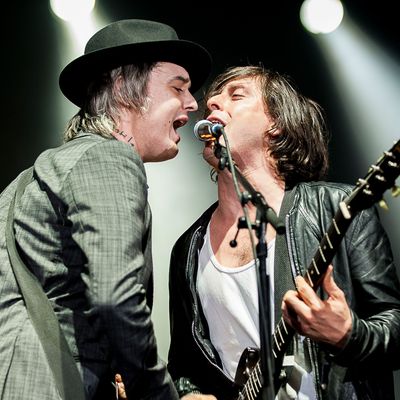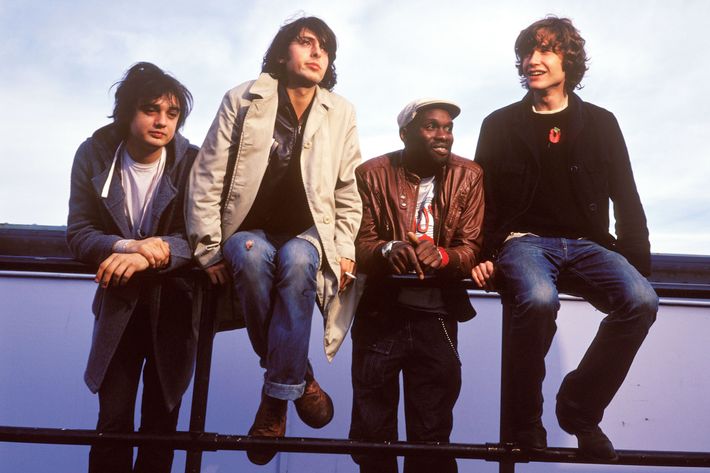
The Libertines released their third album, Anthems for Doomed Youth, on Friday, news that has been greeted with breathless coverage in the U.K. press, and a resounding “Who?” on this side of the Atlantic. The band’s relative lack of a following in the U.S. has always been the biggest joke about them among American fans — as this very site asked in 2010, “Does Anyone in America Care About a Libertines Reunion?” Even among the brief lifespans that defined ‘00s indie rock, the Libertines’ discography is notably sparse; the new album increases their number of original LPs by 50 percent. (More fun stats: When the band’s greatest-hits album was released in 2007, it contained almost one third of their official recorded output.)
The question “Who were the Libertines?” has two equally correct answers. The first, more objectively true answer is four names: Pete Doherty, Carl Barât, John Hassall, and Gary Powell. But in practice, Hassall and Powell were largely ignored in all coverage of the band (including this story). The Libertines, for all intents and purposes, were just Barât and Doherty.
The two met as London teenagers in the ‘90s — Barât, a year older, was rooming with Doherty’s sister — who struck up a creative fellowship, despite not really liking each other all that much. “We didn’t really get on,” Doherty recalled at the height of the band’s fame. “But I was fascinated with ideas he had about himself and the country. I’d never met anyone like him.” This tension between personal dislike and artistic infatuation would form the basis of their lifelong bond. After dropping out of their respective universities, the duo moved to Camden in North London, which was in the process of becoming the musical scene that would spawn Amy Winehouse and the Kills. Unlike Winehouse, neither Barât nor Doherty possessed pure, God-given musical talents, but they had an uncanny knack for self-conception: They would become the model for rock-star-as-drunken-poet, pure artists who put up no walls between themselves and their fans. Possibly because of this, they languished unsigned for years — until the Strokes proved there was a market for arty guitar rock, and voilà, the Libertines were signed to Rough Trade in 2001.
At the time, the notion of the Libertines as “the English Strokes” smarted the band — especially because they’d been formed first. But it was a reasonable comparison that the NME was all too pleased to pile on: Among the international “garage-rock revival” that arose as a counterpoint to the bubblegum pop and rap-rock of the ‘90s, both bands — who played shows together in these days — shared an affinity for jagged guitars and a self-conscious nostalgia for the grittier days of their respective metropolises. For the Strokes, this backward gaze only stretched back to 1967 or so; the Libertines, meanwhile, evoked memories of London’s imperial grandeur, its Dickensian squalor, its postwar malaise. Their characters were sketchily drawn, but evocative: the two thugs who punch the singer in the throat in “Up the Bracket”; the title character in “What a Waster,” “walking like a moron, talking like a spiv;” the cheeky narrator in “I Get Along,” who unleashes the decade’s most perfectly timed “Fuck ‘em.” Their memory of Britain’s ghosts stretched back eons: “The Good Old Days” name-checks the ancient Iceni queen Boudicca, once believed to be buried in North London not far from the Libertines’ own haunts.

Barât and Doherty also established an elaborate group mythology, one in which they were piloting “The good ship Albion” (a metaphor for Britain) toward the paradise of Arcadia. As Doherty (always the member most committed to the idea) once explained, Arcadia is “the realm of the infinity … It’s not a cult or a religion – it’s an awareness of your surroundings; you’re not going to force yourself on anyone and, equally, no one’s going to force themselves on you.” In this, the band embodied what author Ian MacDonald called “the English love of pretending, dressing-up, and being silly” — never more so than in their frequent appearances in red guard jackets. Here, the proper American comparison was not the Strokes, but indie acts like the Fiery Furnaces, the Decemberists, and Joanna Newsom, all of whom were escaping the terror of the Bush years by retreating into fantasy lands of their own.
It’s easy to see a conservative tinge to the group’s patriotic nostalgia — and the Libertines undoubtedly benefited from the conservatism of the British music press, thankful to have another guitar band to anoint as the saviors of rock and roll, as well as that of American Anglophiles, whose mental image of Britain often remains cozily Kinksian — but the band took the Arcadian ideal of “community and pleasure” seriously. They opened their flats to fans for gigs, or even just to hang out, and played a series of guerrilla shows in parks, bus stops, anywhere they could find.
Later, the band’s romantic gaze would turn to these early days, like nostalgia eating its own tail. “We all set out together, and we were focused and there was this romance,” Barât recalled after their breakup. “We all had our world of wine, women and song and the Artful Dodger and ragamuffinry, and after we got signed that paled into an unreality, even though it was there in spirit and mind and intention.”
Why? “Pete wasn’t into drugs then.”
Doherty’s drug habit ramped up even before the band’s first album — 2002’s Up the Bracket — was finished, and remained the defining feature of the band’s fleeting existence. Wikipedia has the full blow-by-blow of the drama; it includes a missed birthday party, multiple unprofessional message-board posts, and one instance of matching-tattoos-as-loyalty-oath. As Doherty variously declined or was prevented from joining the rest of the band on tour, Barât was thrust into the public role of the sober, responsible bandleader — an uncomfortable fit, considering his habit was nearly as large as Doherty’s. (As Doherty mused bitterly in song, “I’m welcome back if I give up crack/ But you gave me my first pipe anyway.”)
While the rest of the Libertines toured Japan without him, Doherty broke into Barât’s flat in revenge, got arrested, and spent two months in prison. This misfortune was enough to spur the band to reembrace him, and on the day of his release, the Libertines played an emotional show in a pub, where Barât and Doherty were photographed looking every inch the rock-and-roll poets they fancied themselves. That photo ended up on the cover of the group’s 2004 self-titled sophomore album, which was marked by the return of the old infighting between the two front men over Doherty’s drug use. Unsurprisingly, that record couldn’t match the lightning-in-a-bottle quality of the band’s debut, though the two self-mythologizing tracks that bookend the album — “Can’t Stand Me Now” and “What Became of the Likely Lads” — are the two best love songs the group ever recorded. (Like the Clash, the band they were most frequently accused of ripping off, all the best Libertines songs are about being in the Libertines.)
From there, the band began to proceed down a well-worn path. Doherty was kicked out of the group and told not to return until he’d gotten clean enough to work. Instead, he chose to focus on his side group Babyshambles, comprised of a rotating cast of hangers-on. As that band’s shambolic albums proved, Doherty never kicked drugs for long. Barât fulfilled the rest of the Libertines’ tour commitments, then disbanded the group in late 2004. Along with Libertines drummer Gary Powell, he, too, formed another band, Dirty Pretty Things; the music of both new groups was weighted down by regrets and recriminations, though they had some good videos.
Pete Doherty started dating Kate Moss, which made him more famous in America than he ever was for his music. From there, it was easy to picture him on the Amy Winehouse trajectory: hounded by tabloids, dead by 30, mourned as a lost genius. Instead, somehow, he stayed alive — sometimes getting clean, sometimes relapsing. (In January, he left a rehab center in Thailand and has reportedly been drug-free since.) He’s released one good solo album; the rest of them, if you squint, have their moments. Carl Barât’s path has been more predictable: He’s gotten sober for real, written a memoir, had kids, gotten into meditation. For both of them, the reasons to reunite eventually overtook the reasons not to, and in 2010, the full band came together for the first time in six years to play a short series of shows in the U.K. This was followed by a concert in Hyde Park last year, and Friday, the release of the third Libertines album. You get the sense that, as the least reliable member of the group, Doherty’s schedule is determining the timing of these reunions more than Barât’s is — the latter just started a new band, the Jackals, and is tasked with trying to get them off the ground at a time when literally every interviewer wants to focus on his old band reuniting. “During this process, I’m having to work out how these two things are different,” he said last year, especially “which songs go with which band.”
After one listen of Anthem for Doomed Youth, the new Libertines sound much like the old Libertines. (I mean, the lead single is about a Rudyard Kipling poem.) But there’s a hang-over to the lyrics in places (often literally), a sense that as Barât and Doherty approach their 40s, the time for self-mythologizing has passed. But it’s easy to put too fine a point on the band’s new maturity: On the morning of the album’s release, Doherty disappeared, leading the band to cancel gigs yet again. A post on the group’s Facebook page only said that he was “safe.”


